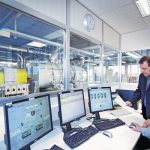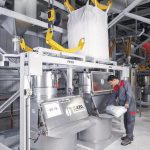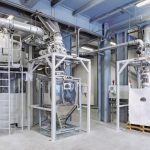Today, the priority is to produce ever-increasing quantities of goods in consistent quality – still using the existing resources, at low cost and without investments that tie up capital. This requires accurate knowledge of the materials, production conditions and operating times for plants and machinery. In addition, a factory-wide reporting system is absolutely essential to keep staff informed. A sophisticated total productivity management programme will have the necessary functionalities.
Author Dieter Herzig Manager, AZO Controls
Production of consumer goods throughout the world is undergoing a process of radical concentration and pressure from the competition is constantly growing. Two factors are of prime importance here: the rate of utilisation of the production line and a reproducible standard of product quality. To compound matters, the rate of utilisation in relation to overall production capacity is relevant in corporate groups with several manufacturing facilities across the globe. In order to remain competitive, perfect logistics are needed, from the commercial level through production and plant management, process control and instrumentation – including technical standards – right through to the process level. The catchword is horizontal integration throughout the value chain, from incoming goods through automatic raw material feeding to the mixing process and culminating in intermediate storage and packing. The incoming goods function already covers storage of raw materials in the respective locations. Information on raw materials and batches is recorded and archived and source receptacles changed to production receptacles by marking with RFID or barcodes. System-based storage functions result in improved production reliability and better transparency of the raw materials available for production, making end-to-end tracking and tracing possible. When it comes to feeding the raw materials, automatic dosing and weighing according to the formulation or recipe provide the foundation for consistently high quality. Continuous documentation and archiving ensure reproducible results. Innovative control engineering helps to save energy and create stable processes, especially when there are no interfaces between feeding and the process itself and all production stages are integrated in the overall automation concept. A uniform operating philosophy with a process workflow that can be defined by the user ensure a high degree of flexibility while an optimised production sequence that takes account of the times required for cleaning and retooling increases productivity.
If not only the horizontal but also the vertical integration – from the ERP system through to the actuator and sensor level – comes from one and the same supplier, this reduces the number of interfaces and thus the potential for inefficiencies. AZO Solids and AZO Controls offer a seamless solution of this kind.
Total productivity management
A TPM programme allows production costs to be cut while production lines and resources can be put to more efficient use and the skills of production and maintenance staff improved. To achieve this, the programme should have functionalities for maintenance and DTM (downtime monitoring), evaluating the level of productivity, assessing the OEE (overall equipment effectiveness) and viability of machinery and plants, calculating KPIs (key performance indicators), the genealogy of the manufactured products, traceability, simulating the production process and company-wide reporting. AZO Controls uses in-house developments and standard products to implement solutions that meet these requirements. Data from the production process is recorded and saved in a real-time database. Suitable modules (DTM/OEE) and programmes (genealogy, simulation) are used to calculate and analyse performance indicators from this raw data, link them together and evaluate them. The resulting information is made available throughout the company using the report manager (RM module). All these functions are combined in a process information (PI) system. The data and informa-tion collected can be accessed by users at any time for further analysis.
The individual modules
The DTM (maintenance and downtime monitoring) module provides answers to questions such as:
- What caused the spike in temperature?
- What is the reduction in downtime as a percentage?
- How much downtime was there during the last shift and which machines were affected?
- Have the tolerance limits for the target weight been adhered to?
Downtimes and alerts can be displayed in lists and sorted according to various criteria. By visualising temperature and humidity trends or on/off times, for example, the constraints of different parameters can be identified clearly and process control optimised accordingly.
Whether production costs are within the budget, what caused the last bottleneck, why shift 3 only achieved 70 % of its target or why too many rejects were manufactured: these are typical issues where the OEE/KPI module helps with its analysis options. OEE is the percentage of the time during which the production line manufactures usable-quality goods. An improvement in OEE has a direct impact on output: OEE is thus an important key performance indicator.
By recording, analysing and displaying the relevant process data in real time, operators can react very quickly in order to adjust the process conditions. Similarly, they can analyse downtime afterwards, rectify what caused it and once again improve the level of productivity (OEE). The period of time over which the indicators for individual machines, lines or entire plants are analysed is user-definable.
The genealogy module allows products to be tracked and traced according to the raw prod-uct and its ingredients. Queries can be generated at any time during the production process to show the interdependencies between individual production steps. It is thus possible to intervene in the manufacturing process in order to make adjustments and modify or regulate production. Since the recorded pa- rameters are saved in a database, they can also be correlated subsequently with the relevant lots or batches. The documentation created in this way provides seamless traceability between raw materials, production parameters and the finished product.
The simulation module allows the production workflow for individual batches to be visualised – if necessary, retrospectively – using the recorded data. The result resembles a kind of “black box” – a clear picture of all parameters that existed at the time of production. Each operator is thus provided with readily understandable information about the plant’s system performance, simplifying decision-making. If there are any deviations from the given parameters during the production process, it is possible to run through different production scenarios by entering the modified input parameters and determine the optimum operating regime.
The overall system also includes a powerful reporting module. This means the operator can generate reports with slight variations and make them accessible to authorised users throughout the company. It goes without saying that these reports can be made available in different versions to different user groups such as maintenance and servicing, plant operators and quality or production management.
Hall 1, Booth 346
cpp-net.com/0314429
Share:









